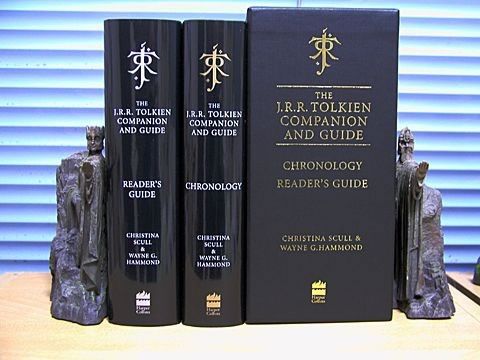The J.R.R. Tolkien Companion and Guide by Christina Scull and Wayne G. Hammond wins the Mythopoeic Scholarship Award in Inklings Studies (07.09.07 by Pieter Collier) - Comments

The J.R.R. Tolkien Companion and Guide Honored with Mythopoeic Scholarship Award in Inklings Studies
The Mythopoeic Society discusses myth, fantasy and imaginative literature in discussion groups across the U.S. and on the internet, in newsletters and scholarly books and journals, and at its annual Mythopoeic Conference. Inspired by the scholarly discussions and writings of the 1930s Oxford University group The Inklings (including C.S. Lewis, J.R.R. Tolkien, and Charles Williams), the Society began in California in 1967.
Every year they give away Literary & Scholarship Awards. The most interesting award for Tolkien fans is The Mythopoeic Scholarship Award in Inklings Studies. It is given to books on J.R.R. Tolkien, C.S. Lewis, and/or Charles Williams that make significant contributions to Inklings scholarship.
The J.R.R. Tolkien Companion and Guide
by Christina Scull and Wayne G. Hammond
A very interesting interview with the authors can be read here.

Christina Scull and Wayne G. Hammond, The J.R.R. Tolkien Companion and Guide
The most impressive book on Tolkien that has been published in 2006 is for sure the two volume book set called the J.R.R. Tolkien Companion and Guide by Christina Scull and Wayne Hammond. It has now been awarded by the Mythopoeic Society! Congratulations! It was well deserved!
Christina Scull is the former librarian of Sir John Soane’s Museum, London. She is the author of "The Soane Hogarths" (1991), edits the journal "The Tolkien Collector", and frequently writes and speaks about Tolkien.
Wayne G. Hammond is a librarian at the Chapin Library of Rare Books at Williams College, Massachusetts. He is the author of "The Graphic Artof C.B. Falls" (1892), "J.R.R. Tolkien:A Descriptive Bibliography" (1993), and regular notes on Tolkien in the journal "Mythlore". Next to this we know them from other important books like J.R.R. Tolkien: Artist & Illustrator, Roverandom, Farmer Giles of Ham 50th anniversary edition, the new expanded index of The Letters of J.R.R. Tolkien, The Lord of the Rings 1954-2004: Scholarship in Honor of Richard E. Blackwelder, and the masterpiece Lord of the Rings: A Reader's Companion.
The Companion and Guide is meant to be a basic reference book for the study and appreciation of the works of J.R.R. Tolkien. Not a replacement for other books, but perhaps a source that one might look at first of all.
The first of its two volumes is an extensive chronology of Tolkien’s life and works, together with family trees, and checklists of Tolkien’s published writings and art, his poems, and translations of his works. The Chronology at times provides almost a day-by-day account, ‘a picture of an extraordinarily busy man’, as we say in our preface, ‘Tolkien the scholar, Tolkien the teacher and administrator, Tolkien the husband and father, Tolkien the creator of Middle-earth’.
The second volume is a long encyclopedia with articles on Tolkien’s writings, on people, places, and institutions important in his life, on the academic world of Leeds and Oxford, and on themes and ideas in his works such as allegory, free will and fate, the environment, women, war. Each volume shares a list of works consulted and a comprehensive index.
The other winners this year are:
Mythopoeic Fantasy Award for Adult Literature:
by Patricia A. McKillip
Paperback: 288 pages
Publisher: Ace Trade
Publication date: January 2, 2007
Language: English
ISBN-10: 0441014658
ISBN-13: 978-0441014651
No stranger to the realms of myth and magic, World Fantasy Award-winning author Patricia A. McKillip presents her first contemporary fantasy in many years-a tale of the tangled lives mere mortals lead, when they turn their eyes from the beauty and mystery that lie just outside of the everyday.
When bookstore owner Sylvia Lynn returns to her childhood home in upstate New York, she meets the Fiber Guild-a group of local women who meet to knit, embroider, and sew-and learns why her grandmother watches her so closely. A primitive power exists in the forest, a force the Fiber Guild seeks to bind in its stitches and weavings. And Sylvia is no stranger to the woods.
Mythopoeic Fantasy Award for Children's Literature:
by Catherine Fisher
Hardcover: 288 pages
Publisher: HarperTeen
Publication date: September 5, 2006
Language: English
ISBN-10: 0060724706
ISBN-13: 978-0060724702
It starts when Cal gets off the train at the wrong stop in the middle of the night, in the middle of nowhere. He’s stranded.
Following a muddy path leads him to a castle that appears to be deserted. But inside is Corbenic, a magnificent hotel filled with rich people preparing for a banquet—and Cal is their guest of honor. During the meal, he experiences a disturbing vision, but when he is asked to talk about what he has seen, he denies it. What if he’s becoming crazy, like his mother?
When Cal wakes the next morning, the elegant castle turns out to be nothing more than an abandoned ruin.…
Mythopoeic Scholarship Award in Myth and Fantasy Studies:
by G. Roland Murphy
Hardcover: 254 pages
Publisher: Oxford University Press, USA
Publication date: July 14, 2006
Language: English
ISBN-10: 0195306392
ISBN-13: 978-0195306392
Product Dimensions: 9.3 x 6.1 x 0.9 inches
The story of the Grail, usually identified as some kind of mystical vessel, has gripped the imaginations of millions since it first appeared in several medieval romances. Of these, Wolfram von Eschenbach's Middle High German Parzival (c. 1210) is generally recognized as the most complex and beautiful. Offering an entirely original reading of Wolfram's famous text, this engrossing and accessible book appeals not only to scholars and students of medieval literature but to anyone who is drawn to the lasting mystery of the Holy Grail.
Spread the news about this J.R.R. Tolkien article: